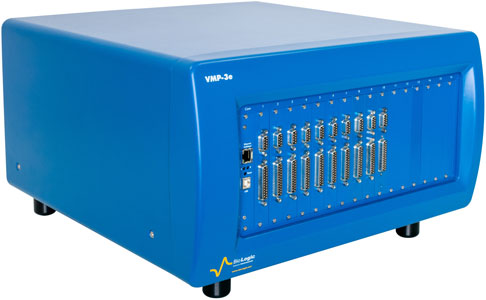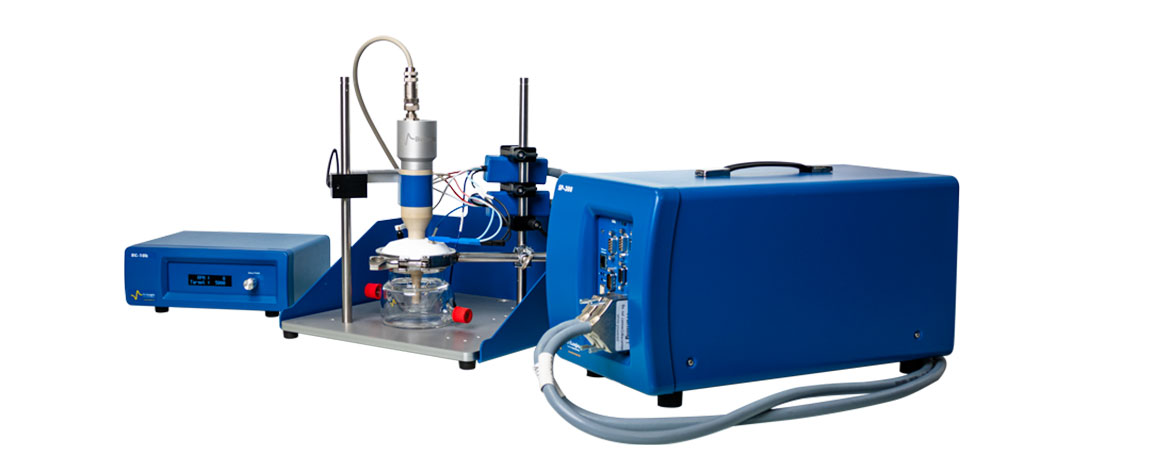News
Design. Create. Innovate.
Posted on: December 10, 2020
Innovation is ingrained in BioLogic’s commercial DNA. The first multi-channel computer-controlled potentiostat (MacPile, 1991), Ethernet connectivity and Embedded EIS are just some of the BioLogic innovations helping scientists working on electrochemistry-based projects around the globe.
This Autumn was important for BioLogic in innovation terms, with the launch of two new products, the VMP-3e potentiostat, the BluRev Rotating Ring Disk Electrode and an important new update for EC-Lab®, BioLogic’s groundbreaking control and analysis software for Electrochemistry.

The brief… take a great potentiostat, the workhorse VMP3, and make it even better.
BioLogic developed the VMP-3e to replace the VMP3, a tried and tested, workhorse electrochemical workstation, which has proven invaluable to scientists in many research fields for years.
“The VMP-3 was a great product, but BioLogic received feedback from clients asking for increased current capability, especially for battery research & testing. Similarly, we knew it was time to upgrade the instrument’s board to the favoured “e” type developed for the Premium potentiostat/galvanostat range to open up upgrade capabilities and enable important new functionality for our clients.
Users have caught on to the benefits of our Quality Indicators, used to validate EIS measurements, previously only available in the Premium range and asked us to add this functionality to new Essential potentiostats”: Aymeric Pellissier/Senior Product Manager (Electrochemistry Division). BioLogic’s development team listened carefully to user feedback and replied with the VMP-3e, an all-round potentiostat, but one that offers particular value to researchers specializing in batteries.
The VMP-3e’s standard voltage range of ±10 V is extendable to -20 V to +20 V and the 1 A default current range can reach 60V and 800A through BioLogic’s FlexP booster range. Current can also be brought down to 20nA through upgrade modules that can be retrofitted by the user, effectively “future-proofing” the instrument and ensuring it grows with users’ needs.
Up to 16 channels can be added to the VMP-3e, which is the second potentiostat in our Essentials range with built-in Quality Indicators after the VSP-3e, enabling users to validate EIS in the instruments 1 MHz to 10 µHz range.
Click here for more information.

BluRev RRDE: The Lord of the Ring
The RRDE is the latest addition to our BluRev range of accessories and complements the Rotating disk electrode, launched by BioLogic in 2019.
The addition of a concentric ring to the BluRev RDE (Rotating Disk Electrode), allows the user to collect species produced on the disk. Homogeneous bulk reactions of intermediate species produced at the disk can be studied by comparing experimental data to theoretical terms.
One major difference between BioLogic’s RRDE and rival Rotating Ring Disk Electrode’s is an LCD screen indicating the both the desired and the measuring instrument’s rotation speed. This useful functionality can help users monitor experiments in real-time. Users can record both target and measured speeds in EC-Lab®, for future reference.
Another great BluRev Rotating Ring Disk Electrode feature is that users can easily program and perform a Levich and Koutecký-Levich experiment all in one go, using EC‑Lab®, and also exploit the new EIS element Winf for direct access to the diffusion coefficient.
BioLogic constantly looks to its users for information to help improve product design. One such example can be found in the development of the RRDE, which features a gas inlet to purge the inner part of the instrument’s body and prevent corrosion to its stainless steel shaft.
BioLogic invested significant effort in the RRDE design to ensure a maximal runout of the shaft of +/- 50 µm, ensuring a laminar flow of electroactive species to the electrode and the validity of Levich and Koutecký-Levich analyses.
A purpose built-enclosure compatible with both the BluRev RDE/RRDE for EL-ELECTRO cells is available, offering high levels of flexibility for experiment setups. Other cells are compatible with this enclosure with an adaptor cap.
The BluRev RRDE is compatible with bipotentiostats such as the BP-300 or the fast, sensitive and modular two-channel SP-300 and any potentiostat with an analog output.
Major applications for RRDE instruments include hydrogen production, depollution, electrochemical sensing and most notably hydrogen fuel cells where RRDEs play a vital role in generating fundamental information to help optimize the efficiency of the hugely expensive catalytic components (often platinum) used in their production.
Click here for more information.
BluRev RRDE: Which potentiostat?
The BioLogic SP-300 is your first choice for RRDE experiments, due to its two independent measurement channels, low current capabilities, analog filtering and integrated high frequency EIS measurements
For specific needs and users interested in fast electrochemical kinetics, short-lived species and low detection limits requiring fast scans and low current range, users might favor the BP-300, with its built-in Analog Ramp Generator and low current cables (down to 1 pA) as standard
EC-Lab® Update
BioLogic constantly adds new features, functionality and techniques to EC-Lab®, with, on average two updates per year.
The most recent update took place in November, with important new features added to our benchmark control and analysis software.
On the “instrument control” side of EC-Lab®, bipot techniques have been improved to allow the user to add ohmic drop compensation or modify the rotation speed of RRDEs automatically.
On the analysis side, we improved 3D graphic rendering of Z inst as well as adding increased personalization for the tool.
Potentiostat Rotating ring disk electrode VMP3e Potentiostat Potentiostat/Galvanostat EC-Lab Innovation



